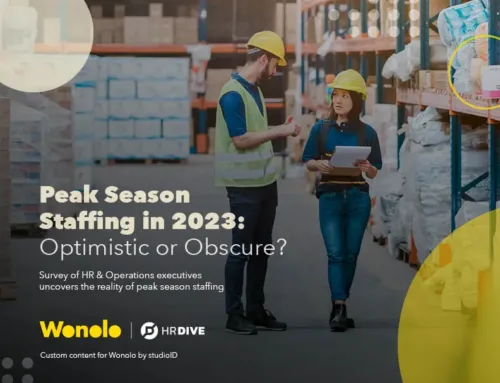Wonolo
If you have a will to work then you should be able to work. That’s one of the foundational beliefs for us at Wonolo. Unfortunately, things aren’t always so simple.
One of the barriers to work can be a lack of formal education. A four-year college degree is increasingly becoming mandatory for many positions, which makes it difficult for otherwise skilled and dedicated workers to advance. This is sometimes called “degree inflation.”
At the same time, companies frequently say they can’t find the workers they need. This is called the skills gap.
One of the people trying to solve the skills gap and help workers advance is Papia Debroy, the Vice President of Insights at Opportunity@Work. Opportunity@Work grew out of an initiative at the White House under President Barack Obama and is dedicated to helping workers reach their full potential.
Papia and her colleagues at Opportunity@Work, and researchers from Harvard University, Cornell University, and Accenture recently published an economic report about how workers oftentimes have skills that could lead them to higher-paying work – if only they and businesses had a better understanding of how their skills transferred to other jobs.
Below is a Q&A with Papia.
- Tell me about your first job.
- My first job was as a babysitter when I was in junior high school. On my first day, the kid I was babysitting got stung by a bee and had an allergic reaction to the sting! There are a lot of skills you have to build when working with kids – patience, creativity, the ability to communicate clearly. I still use all those skills today.
- What does “the future of work” mean to you?
- The future of work is a reflection about how the nature of work is changing. These shifts impact jobs and the workplace, and of course, impact the worker. If employers play an active role in driving inclusivity in their planning around these changes, if we recognize workers for their talents and skills that they’ve earned through training, on-the-job learning and other alternative paths, we’ll make some headway toward overcoming some of the disparate outcomes we see in the workplace now and be able to realize a workplace that is more inclusive.
- You recently released a report about how there are 71 million workers who have a high school diploma or equivalent and do not have a four-year college degree but do have the skills to perform higher-wage work today. Can you tell me about these workers? You call them STARS?
- STARs are workers Skilled Through Alternative Routes. They are currently active in the workforce, have a high school diploma, and do not have a bachelor’s degree but developed skills on-the-job and through other routes like community college or apprenticeships. STARs who are currently in the workforce earn on average, 13% less than they did in the last generation. However, our analysis of these workers, their jobs, and their skills – using the Current Population Survey and the Department of Labor’s O*NET data – shows the vast majority of them could perform in roles that pay higher wages if they were given access and opportunity.
- In the report, you note that brickmasons in Florida earn about $13.71 an hour but welders earn $23.91 an hour even though they both require similar skills. That’s a big gap. The real issue is a lack of information, right?
- What we illustrate in our analyses is that the labor market isn’t working for a lot of workers: their skills don’t meaningfully translate to higher earnings for more than half the workforce. The challenges to fixing these barriers are numerous; certainly, there are information problems – workers lack information about what jobs exist, what skills are required for them, what pathways are accessible to land those jobs. But beyond the information problems, there are collective action problems (for example, why should one employer remove the degree requirement if another is requiring it?), coordination problems (for example, what are the most valuable skills in a local labor market?), access challenges (for example, when someone has the skills, shouldn’t they be given the opportunity to get the job?) and power dynamics (for example, what recourse do workers have if they are screened out and rejected from a job despite having the skills required to do it?). It’s a systemic failure that will require collaboration to solve, and not a singular one-off item that can be fixed alone, unfortunately.
- Does this information asymmetry affect minorities more?
- This collective failure absolutely affects minorities more. Degree requirements screen out 67% of Black workers and 79% of Hispanic workers. Our latest data on essential workers provides just a snapshot of the impact of these inequities. 52% of all Black workers and 59% of Hispanic workers are in essential jobs, compared to 40% of white workers. Further, over 60% of essential Black and Hispanic STARs are in low wage jobs, compared to 49% of essential white STARs. And with 71% of high-wage essential STAR jobs held by white STARs, their pathways to economic mobility opportunities are also limited.
- In the context of our current economy, when millions are unemployed, what does this mean?
- Because of the disparate impact on these communities, it leaves precisely these populations more vulnerable in this crisis. They are the most likely to experience disruptions in their job trajectories and have the most trouble recovering. Those who were already behind are likely to fall further behind, unless we take intentional steps towards an inclusive recovery.
- If I’m a worker reading this who is a STAR, what should I do?
- As a STAR, share your story: you have the power to shift mindsets and light the way for others by giving voice to your success stories and the barriers you face.
- If I’m a business owner reading this, what should I do?
- Business owners can take concrete steps to support STARs. First, shift to skills-based hiring practices: remove the four-year degree requirement! Second, identify and intentionally recruit from alternative routes, such as community colleges and local training providers to find the STARs talent you need. And third, invest in the STARs already inside your company today, and ensure they have opportunities to leverage their skills in higher-value opportunities.


![[Report] Beyond the Gig: Exploring Reliable Work Options for the Modern Workforce](https://info.wonolo.com/wp-content/uploads/2023/10/Worker-Preferences-Report-Header-Image-500x383.png)



